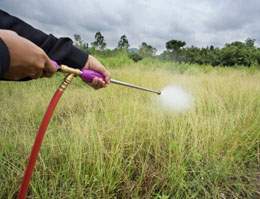Identification of the weeds is a mandatory step in order to select correct herbicides for lawns. The pre-emergence herbicides are best for controlling annual weeds, while perennial ones respond well to selective post-emergence types.

Growth of invasive weeds is not only a concern for vegetable and flower gardeners, but it is a common problem faced by lawn owners. The simplest cultural approach for controlling their growth is developing uniform, healthy turf all over the area so that you don't leave room for them. Nevertheless, maintaining a lustrous-green lawn grass, without brown patches and weeds, is easier said than done. So, a practical solution left with you is applying safe herbicides in proper concentration.
Common Lawn Weeds: Identification
Majority of them are grasses (for example, crabgrass, quackgrass, and bluegrass) that are different from the planted lawn grass types. They are monocots, and grouped under weedy grasses. At the time of sprouting, you can identify them from the single seed leaf, while the leaves of mature plants have parallel venation. Contrary to this, there are broadleaf weeds that comprise dicot plants such as clover, plantain, and ground ivy. These germinate with two seed leaves.
Another way of classifying them is based on their growth habit. For example, annual weeds complete their life cycle within one growing year, while biennial ones continue to grow for two successive years. The worst of all is the perennial type, which tends to grow for several years. Hence, without prompt control, they produce seeds and spread to larger areas gradually. Correct identification of weeds helps in choosing appropriate herbicides to get rid of them.
Lawn Herbicides: An Overview
The worst part with lawn weeds is you cannot uproot them manually, which is possible in vegetable gardening. They not only compete with the grass for moisture and nutrients but also reduce the aesthetic value of the lawn due to color and texture differences. With time, increased growth is observed, thereby resulting in thinning of grass. Indeed, dealing with weeds is very challenging, even for people who already have a green thumb in gardening.
Their mass growth is a sign of problem in grass growing, and effective growth control involves addressing it promptly. If you get rid of them today, very soon you will notice new sprouts within the next few weeks. Hence, it is better to correct the root cause first, and deal with them afterward. A simple logic is to alter lawn care methods that you have adopted till date. Controlling weeds can be achieved by changing the frequency of soil aeration, mowing height, irrigation frequency, and fertilization.
For recurrent weed problems, changing cultural practices, along with herbicide spraying, is suggested for better results. While selective herbicides kill undesirable ones, non-selective type is used for mass killing of grass and plants in a specific area. Based on the mode of working, there are two basic groups of herbicides, which are explained as follows:
Pre-emergence
They are excellent for crabgrass control, and killing other annual weeds like bluegrass and goose grass. As the name signifies, these herbicides are applied before the weed seeds germinate. For using such products, you need to know their probable germination time. Keep the soil moist, and apply them for 2 - 3 weeks before sprouting of their seeds.
Post-emergence
They work exactly opposite to the pre-emergence type. If you are a newbie in growing lawn grass and spraying herbicides, consider using selective post-emergence type. It is effective for controlling perennial varieties. As soon as these weeds begin to grow actively, apply it. To ensure maximum absorption of the product, keep the soil moist before applying one.
As far as possible, use organic herbicides, instead of the chemically derived products. Also, take your local horticulturist's opinion, while selecting one for your lawn. Follow the recommended directions, in terms of dose and application methods, to reap maximum benefits of such products.






 Growth of invasive weeds is not only a concern for vegetable and flower gardeners, but it is a common problem faced by lawn owners. The simplest cultural approach for controlling their growth is developing uniform, healthy turf all over the area so that you don't leave room for them. Nevertheless, maintaining a lustrous-green lawn grass, without brown patches and weeds, is easier said than done. So, a practical solution left with you is applying safe herbicides in proper concentration.
Growth of invasive weeds is not only a concern for vegetable and flower gardeners, but it is a common problem faced by lawn owners. The simplest cultural approach for controlling their growth is developing uniform, healthy turf all over the area so that you don't leave room for them. Nevertheless, maintaining a lustrous-green lawn grass, without brown patches and weeds, is easier said than done. So, a practical solution left with you is applying safe herbicides in proper concentration.